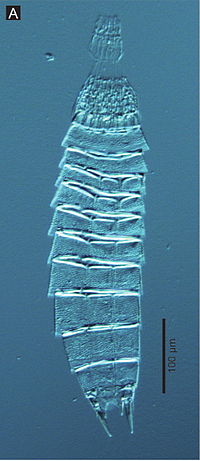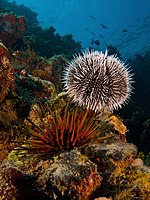
Phylogenomic analyses of mud dragons (Kinorhyncha).
Sign Up to like & getrecommendations! Published in 2021 at "Molecular phylogenetics and evolution"
DOI: 10.1016/j.ympev.2021.107375
Abstract: Mud dragons (Kinorhyncha) are microscopic invertebrates, inhabiting marine sediments across the globe from intertidal to hadal depths. They are segmented, moulting animals like arthropods, but grouping with the unsegmented priapulans and loriciferans within Ecdysozoa. There… read more here.
Keywords: genera; analyses mud; dragons kinorhyncha; mud dragons ... See more keywords

Phylogenomic analyses highlight innovation and introgression in the continental radiations of Fagaceae across the Northern Hemisphere
Sign Up to like & getrecommendations! Published in 2022 at "Nature Communications"
DOI: 10.1038/s41467-022-28917-1
Abstract: Northern Hemisphere forests changed drastically in the early Eocene with the diversification of the oak family (Fagaceae). Cooling climates over the next 20 million years fostered the spread of temperate biomes that became increasingly dominated… read more here.
Keywords: continental radiations; analyses highlight; introgression; innovation ... See more keywords

ALPHA: a toolkit for Automated Local PHylogenomic Analyses
Sign Up to like & getrecommendations! Published in 2018 at "Bioinformatics"
DOI: 10.1093/bioinformatics/bty173
Abstract: Summary The evolutionary histories of individual regions across a genomic alignment-called 'local genealogies'-can differ from each other, due to processes such as recombination. Elucidating and analyzing these local genealogies are important for a large number… read more here.
Keywords: phylogenomic analyses; automated local; local genealogies; toolkit automated ... See more keywords

Comparing Ultraconserved Elements and Exons for Phylogenomic Analyses of Middle American Cichlids: When Data Agree to Disagree
Sign Up to like & getrecommendations! Published in 2021 at "Genome Biology and Evolution"
DOI: 10.1093/gbe/evab161
Abstract: Abstract Choosing among types of genomic markers to be used in a phylogenomic study can have a major influence on the cost, design, and results of a study. Yet few attempts have been made to… read more here.
Keywords: ultraconserved elements; phylogenomic analyses; genomic markers; elements exons ... See more keywords

Phylogenomics Supports the Monophyly of Aphelids and Fungi and Identifies New Molecular Synapomorphies.
Sign Up to like & getrecommendations! Published in 2022 at "Systematic biology"
DOI: 10.1093/sysbio/syac054
Abstract: The supergroup Holomycota, composed of Fungi and several related lineages of unicellular organisms (Nucleariida, Rozellida, Microsporidia, and Aphelida), represents one of the major branches in the phylogeny of eukaryotes. Nevertheless, except for the well-established position… read more here.
Keywords: phylogenomic analyses; supports monophyly; molecular synapomorphies; hypothesis ... See more keywords

Phylogenomic Analyses of Hepatica Species and Comparative Analyses Within Tribe Anemoneae (Ranunculaceae)
Sign Up to like & getrecommendations! Published in 2021 at "Frontiers in Plant Science"
DOI: 10.3389/fpls.2021.638580
Abstract: Hepatica is a small genus of Ranunculaceae with medicinal and horticultural value. We characterized nine complete chloroplast (cp) genomes of Hepatica, which ranged from 159,549 to 161,081 bp in length and had a typical quadripartite… read more here.
Keywords: anemoneae; phylogenomic analyses; analyses hepatica; hepatica ... See more keywords

Phylogenomic Analyses of the Tenthredinoidea Support the Familial Rank of Athaliidae (Insecta, Tenthredinoidea)
Sign Up to like & getrecommendations! Published in 2022 at "Insects"
DOI: 10.3390/insects13100858
Abstract: Simple Summary In the current era of data explosion, the use of genetic information is increasingly being applied across numerous biological questions. One application has been to develop more robust evolutionary frameworks. Such well-resolved phylogenetic… read more here.
Keywords: phylogenomic analyses; athalia related; related genera; support ... See more keywords

Phylogenomic analyses of echinoid diversification prompt a re-evaluation of their fossil record
Sign Up to like & getrecommendations! Published in 2022 at "eLife"
DOI: 10.7554/elife.72460
Abstract: Echinoids are key components of modern marine ecosystems. Despite a remarkable fossil record, the emergence of their crown group is documented by few specimens of unclear affinities, rendering their early history uncertain. The origin of… read more here.
Keywords: fossil; fossil record; analyses echinoid; phylogenomic analyses ... See more keywords